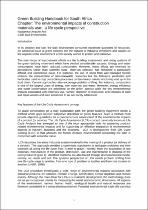JavaScript is disabled for your browser. Some features of this site may not work without it.
- ResearchSpace
- →
- Research Publications/Outputs
- →
- Book Chapters
- →
- View Item
| dc.contributor.author |
Ampofo-Anti, N

|
|
| dc.date.accessioned | 2009-05-18T13:42:22Z | |
| dc.date.available | 2009-05-18T13:42:22Z | |
| dc.date.issued | 2009-02 | |
| dc.identifier.citation | Ampofo-Anti, N. 2009. Environmental impacts of construction materials use: a life cycle perspective. Green building handbook South Africa, Volume 1: (A guide to ecological design), pp 1-9 | en |
| dc.identifier.isbn | 9780620427241 | |
| dc.identifier.uri | http://hdl.handle.net/10204/3386 | |
| dc.description | Author Posting. Copyright Green Building, 2008. This is the author's version of the work. It is posted here by permission of Green Building for personal use, not for redistribution | en |
| dc.description.abstract | To place construction on a truly sustainable path the green building movement needs a method which goes beyond subjective checklists of green features. Such a method must provide objective guidelines for a comprehensive assessment of the environmental impacts of a product (or service). The Life Cycle Assessment (LCA) concept previously known as Life Cycle Analysis has emerged as one of the most appropriate tools for assessing product-related environmental impacts and for supporting an effective integration of environmental aspects in industry, business and the economy. LCA is distinguished from Life Cycle Costing (LCC) in that whereas the former involves environmental accounting the later is concerned with economic value. The primary application of LCA in the built environment professions is to inform design decisions, in particular, provide quantitative data to guide the selection of construction material, construction component and building system combinations which will reduce the life cycle environmental impacts of a built facility. While the decisions made throughout the building life cycle will influence the impact it can have on the environment, materials choices made in the pre-use phase commit the major environment impacts which occur in the use phase. Environmental concerns, for instance potential contributions to Climate Change must therefore be addressed side by side with more traditional concerns such as thermal comfort, health, safety, cost and maintenance from the planning and design stages | en |
| dc.language.iso | en | en |
| dc.publisher | Green Building | en |
| dc.subject | Green building | en |
| dc.subject | Construction materials | en |
| dc.subject | Environmental impacts | en |
| dc.subject | Building materials | en |
| dc.subject | Sustainable development | en |
| dc.subject | Life cycle assessment | en |
| dc.subject | LCA | en |
| dc.subject | Life cycle analysis | en |
| dc.subject | Green building handbook South Africa | en |
| dc.title | Environmental impacts of construction materials use: a life cycle perspective | en |
| dc.type | Book Chapter | en |
| dc.identifier.apacitation | Ampofo-Anti, N. (2009). Environmental impacts of construction materials use: A life cycle perspective., <i></i> Green Building. http://hdl.handle.net/10204/3386 | en_ZA |
| dc.identifier.chicagocitation | Ampofo-Anti, N. "Environmental impacts of construction materials use: a life cycle perspective" In <i></i>, n.p.: Green Building. 2009. http://hdl.handle.net/10204/3386. | en_ZA |
| dc.identifier.vancouvercitation | Ampofo-Anti N. Environmental impacts of construction materials use: a life cycle perspective. [place unknown]: Green Building; 2009. [cited yyyy month dd]. http://hdl.handle.net/10204/3386. | en_ZA |
| dc.identifier.ris | TY - Book Chapter AU - Ampofo-Anti, N AB - To place construction on a truly sustainable path the green building movement needs a method which goes beyond subjective checklists of green features. Such a method must provide objective guidelines for a comprehensive assessment of the environmental impacts of a product (or service). The Life Cycle Assessment (LCA) concept previously known as Life Cycle Analysis has emerged as one of the most appropriate tools for assessing product-related environmental impacts and for supporting an effective integration of environmental aspects in industry, business and the economy. LCA is distinguished from Life Cycle Costing (LCC) in that whereas the former involves environmental accounting the later is concerned with economic value. The primary application of LCA in the built environment professions is to inform design decisions, in particular, provide quantitative data to guide the selection of construction material, construction component and building system combinations which will reduce the life cycle environmental impacts of a built facility. While the decisions made throughout the building life cycle will influence the impact it can have on the environment, materials choices made in the pre-use phase commit the major environment impacts which occur in the use phase. Environmental concerns, for instance potential contributions to Climate Change must therefore be addressed side by side with more traditional concerns such as thermal comfort, health, safety, cost and maintenance from the planning and design stages DA - 2009-02 DB - ResearchSpace DP - CSIR KW - Green building KW - Construction materials KW - Environmental impacts KW - Building materials KW - Sustainable development KW - Life cycle assessment KW - LCA KW - Life cycle analysis KW - Green building handbook South Africa LK - https://researchspace.csir.co.za PY - 2009 SM - 9780620427241 T1 - Environmental impacts of construction materials use: a life cycle perspective TI - Environmental impacts of construction materials use: a life cycle perspective UR - http://hdl.handle.net/10204/3386 ER - | en_ZA |






